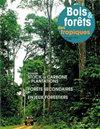为墨西哥南部热带干燥森林退化土地的再造林,在树木苗圃中进行轻管理,以生产毛竹幼苗
IF 0.6
4区 农林科学
Q3 FORESTRY
引用次数: 1
摘要
苗圃做法的选择对于生产高质量的幼苗和提高干燥热带地区再造林人工林的成活率非常重要。然而,需要为繁殖信息匮乏的本地物种建立适当的做法。该研究表明,苗圃的光照管理是未来种植成功的关键栽培措施,因为植物在不同的光照条件下通常会发生形态生理变化。研究了在4种光照水平(20%、40%、60%和100%光合有效辐射[PAR])的苗圃条件下生产的细绒球(picelellobium dulce)植株形态、光合效率和生长的变化。我们还根据植物生长的光照条件评估了种植后的存活率。在三个月大的植物中检测形态生理变量。利用苗木在田间建立人工林,每月记录其成活率,持续17个月。苗圃内光照水平对苗木形态、光合效率和生长均有显著影响。在大多数变量中,60% PAR水平有利于获得最佳结果,而在20% PAR水平下生长的植株最不成功。苗木成活率因苗圃光照水平的不同而有显著差异,在苗木生产期间,苗圃光照强度越大,苗木成活率越高。在100% PAR条件下生产的幼苗成活率为100%,而在20% PAR条件下生长的幼苗成活率最低(53%)。因此,光管理作为一种栽培方法,通过影响白豆幼苗的质量显示出潜力,在60% PAR条件下的苗圃中,白豆幼苗的质量得到改善。然而,在充分阳光下生产的植株在种植后的成活率更高。这些结果将有助于在干旱热带地区退化土地恢复项目中改善杜鹃苗圃的管理和建设。本文章由计算机程序翻译,如有差异,请以英文原文为准。
Light management in tree nurseries to produce Pithecellobium dulce seedlings for the reforestation of degraded lands in Southern Mexico's tropical dry forests
The choice of nursery practices is important to the production of high-quality seedlings and to increase the survival rates of reforestation plantations in the dry tropics. However, adequate practices need to be established for native species for which propagation information is scarce. This study suggests that light management in nurseries is a key cultivation practice for future planting success, because of the morpho-physiological changes that plants usually undergo in different light conditions. We examined variations in the morphology, photosynthesis efficiency and growth of Pithecellobium dulce plants produced under four levels of light in nursery conditions (20%, 40%, 60%, and 100% of photosynthetically active radiation [PAR]). We also assessed survival after planting out according to the light conditions under which the plants were grown. Morpho-physiological variables were examined in three-month-old plants. A plantation was established in the field using the nursery-grown plants, and their survival was recorded monthly for 17 months. In the nursery, the light levels had significant effects on morphology, photosynthesis efficiency and growth. The 60% PAR level was favourable to optimum results for most of the variables, whereas the least successful results were found in plants grown at 20% PAR. Seedling survival in the field differed significantly according to the nursery light level, increasing with greater light intensity in the nursery during seedling production. 100% survival was observed in seedlings produced under 100% PAR, whereas the lowest survival rate (53%) was found in seedlings grown under 20% PAR. Light management thus shows potential as a cultivation practice by affecting the quality of P. dulce seedlings, which is improved in the nursery at 60% PAR. However, better survival after planting out is obtained with plants produced under full sun. These results should help to improve nursery management and establishment in the field of P. dulce in projects to restore degraded lands in the dry tropics.
求助全文
通过发布文献求助,成功后即可免费获取论文全文。
去求助
来源期刊

Bois et Forets Des Tropiques
FORESTRY-
CiteScore
1.50
自引率
16.70%
发文量
31
审稿时长
>12 weeks
期刊介绍:
In 1947, the former Tropical Forest Technical Centre (CTFT), now part of CIRAD, created the journal Bois et Forêts des Tropiques. Since then, it has disseminated knowledge and research results on forests in intertropical and Mediterranean regions to more than sixty countries. The articles, peer evaluated and reviewed, are short, synthetic and accessible to researchers, engineers, technicians, students and decision-makers. They present original, innovative research results, inventions or discoveries. The journal publishes in an international dimension. The topics covered are of general interest and are aimed at an informed international audience.
 求助内容:
求助内容: 应助结果提醒方式:
应助结果提醒方式:


